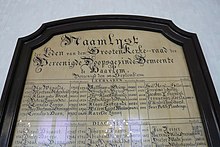Doopsgezinde kerk, Haarlem

The Doopsgezinde kerk is a historical hidden Mennonite church dating from the 17th century between the Grote Houtstraat, Peuzelaarsteeg and the Frankestraat in Haarlem, Netherlands.
History[edit]

The church (also referred to as the Vermaning) was built in 1683.[1] The original entrance was a simple narrow door in the alley connecting the shopping street Grote Houtstraat to the Frankestraat, called the Peuzelaarsteeg, and through the purchase of a house in the Frankestraat a new, larger, entrance was created in 1717. In 1757 a group of members of the church, including Pieter Teyler van der Hulst, purchased a house on the Grote Houtstraat and created a modern but unobtrusive entrance with long hallway. In 1902 the Frankestraat entrance was renovated and new regents’ rooms were created in Jugendstil. During the course of centuries, almost the entire block of houses was purchased by the church, and a large house across from the church in the Frankestraat, the "Huis ter Kleef", was used as an orphanage.[2] The house on the corner of the Peuzelaarsteeg and the Grote Houtstraat (nr. 51) also was purchased by Pieter Teyler, and he rented it to the Dutch Society of Science for their museum, which was the first museum in Haarlem that opened its doors in 1777.
-
Interior with organ.
-
Gallery for the orphans with watchhouse for the orphan governess
-
Pulpit with baroque brass sermon holder
-
Former alley joined the former courtyard to the former entrance on the Peuzelaarsteeg
-
Former courtyard converted to hallway
-
Regents room from 1902
List of teachers[edit]


The church calls its ministers teachers, and the names are written on a large name board in one of the meeting rooms, along with a list of deacons. In 1804 a songbook Christelijke Gezangen en Liederen was published in Haarlem of 150 songs with accompanying music. It had a title vignette by Reinier Vinkeles and a forward which was signed by the teachers Klaas van der Horst, Petrus Loosjes Az., Barend Hartman van Groningen, Matthias van Geuns Jz], Martinus Bodisco and Adriaan Loosjes Pz. Aagje Deken wrote the text for 74 of these songs for which she asked 4 ducats (21 guilders) compensation per page.[3]
| Called | Teacher | Died |
|---|---|---|
| 1736 | Age Wijnalda | 1792 |
| 1757 | Martinus Arkenbout | 1790 |
| 1761 | Klaas van der Horst | 1825 |
| 1762 | Petrus Loosjes Adr. | 1813 |
| 1763 | Cornelis Loosjes | 1792 |
| 1770 | Barent Hartman van Groningen | 1806 |
| 1792 | Cornelis de Haan | 1793 |
| 1792 | Matthias van Geuns Jz | 1839 |
| 1803 | Abraham de Vries | 1862 |
| 1807 | Sijbren Klaases Sijbrandi | 1854 |
| 1828 | Sijtze Klazes de Waard | 1856 |
| 1838 | Klaas Sijbrandi | 1872 |
| 1839 | Willem Carel Mauve | 1869 |
| 1856 | Karel de Lanoij | |
| 1863 | Hendrik Arend van Gelder | 1899 |
| 1872 | Jeronimus de Vries | |
| 1884 | Jacobus Craandijk | |
| 1890 | Leonardus Hesta | 1901 |
| 1900 | Dr. Hendrik Jan Elhorst | |
| 1901 | Broer Pieter Plantenga |
References[edit]
- ^ Rijksmonument report
- ^ Van de schuilkerk naar de Wereld; 1967 publication by the church
- ^ letter to Adriaan Loosjes by Aagje Deken, 20 February 1802, the Hague, in the DBNL






